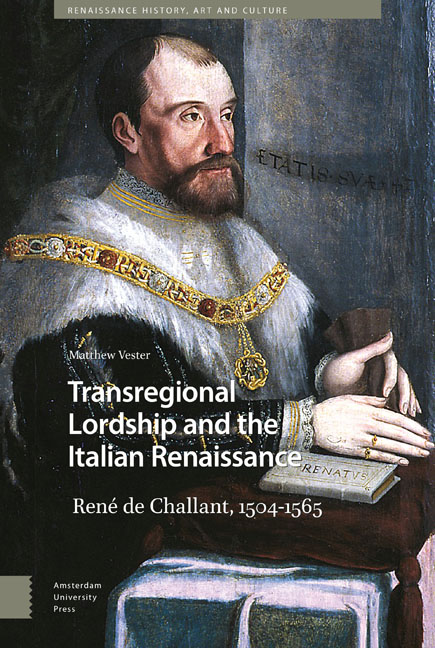Book contents
- Frontmatter
- Contents
- Maps and Tables
- Abbreviations
- Acknowledgments
- 1 On the edge of the Italian Renaissance
- 2 René's early career to 1536
- 3 René's growing influence during the war years, 1536-1553
- 4 René and Duke Emanuel Filibert
- 5 Kinship and noble life
- 6 The Challant political networks
- 7 Finance and brokerage
- 8 Lordship
- 9 The embodiment of spatial politics
- About the author
- Index
3 - René's growing influence during the war years, 1536-1553
Published online by Cambridge University Press: 21 November 2020
- Frontmatter
- Contents
- Maps and Tables
- Abbreviations
- Acknowledgments
- 1 On the edge of the Italian Renaissance
- 2 René's early career to 1536
- 3 René's growing influence during the war years, 1536-1553
- 4 René and Duke Emanuel Filibert
- 5 Kinship and noble life
- 6 The Challant political networks
- 7 Finance and brokerage
- 8 Lordship
- 9 The embodiment of spatial politics
- About the author
- Index
Summary
Abstract
In 1536, the Sabaudian lands were invaded by the Bernese and the French. René de Challant, as Marshal of Savoie, struggled to learn what was happening and how the Duke of Savoy wished him to respond. He eventually fell back to the Valle d’Aosta and oversaw its defensive efforts. Together with the Bishop of Aosta and an executive committee of the valley estates assembly (the Conseil des Commis), he preserved the valley's devotion to the House of Savoy throughout the Franco-Swiss occupation of most of the Sabaudian lands. He continued to serve Charles III diplomatically over the course of the wars, while fighting with the Orléans-Longueville family over the sovereign status of Valangin.
Key words: Berne, Francis I, Charles III, Commis, Valangin
The invasions of 1536
In the mid 1530s, the Sabaudian lands were almost eliminated from the European map as a result of multipronged invasions and occupations. These events transformed the political-geographic context of René's position as a transregional lord and political agent acting on behalf of himself and others (especially the House of Savoy). In 1535, the Duke of Savoy initiated a blockade of Geneva, whose authorities appealed to Berne. The Bernese did not wish to act alone to protect the city, which, in August 1535, prohibited the celebration of the Mass. Various Bernese had pledged themselves as security for Sabaudian loans and were also afraid that they would lose their credit if the Duke were ruined by an invasion. But the calculus of Bernese leaders began to change when they learned that Charles V's army, which might have intervened on behalf of the Duke of Savoy, had embarked for Africa. In September, the Swiss Diet renounced its previous efforts to mediate between Berne and the Duke; in October, mercenaries were raised in the county of Neuchâtel (including Valangin) and defeated a contingent of Savoyards before being persuaded by Bernese envoys to go home. Meanwhile, Berne gave Charles III an ultimatum: lift the blockade or their alliance would be broken.
The Duke stalled for time, a hastily organized conference in Aosta produced nothing, and the Duke ‘returned to Piedmont, consigning his affairs to God's will and protection’.
- Type
- Chapter
- Information
- Transregional Lordship and the Italian RenaissanceRené de Challant, 1504–1565, pp. 77 - 108Publisher: Amsterdam University PressPrint publication year: 2020

